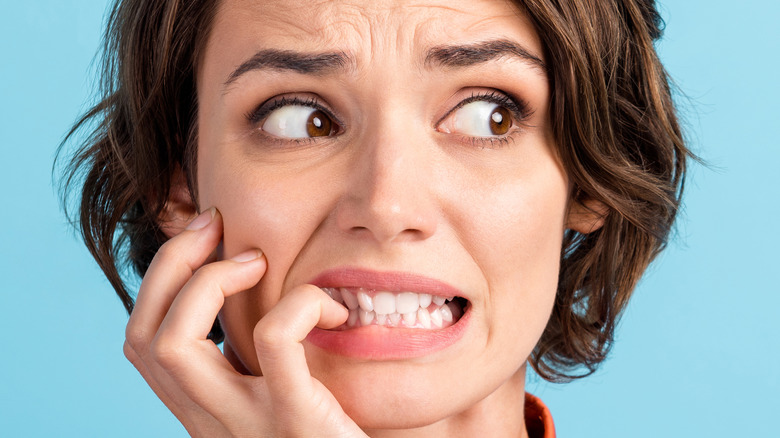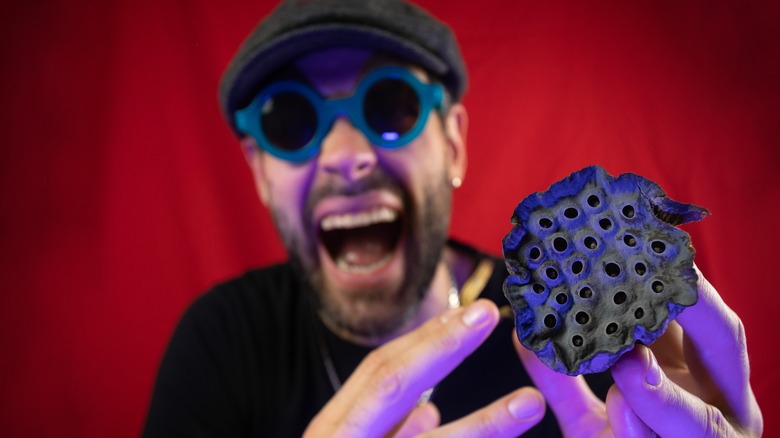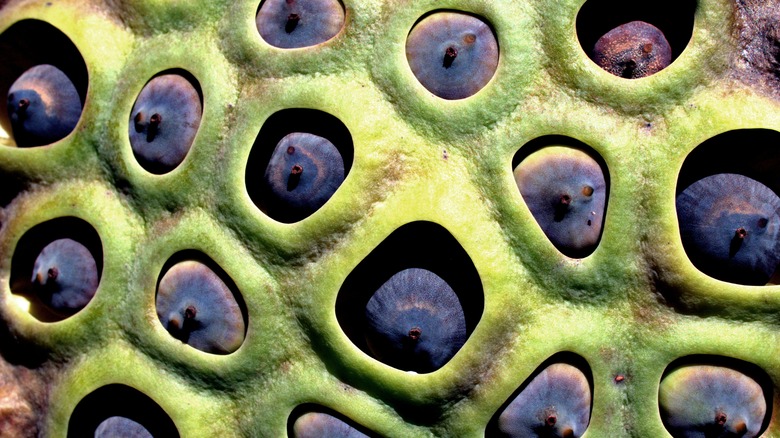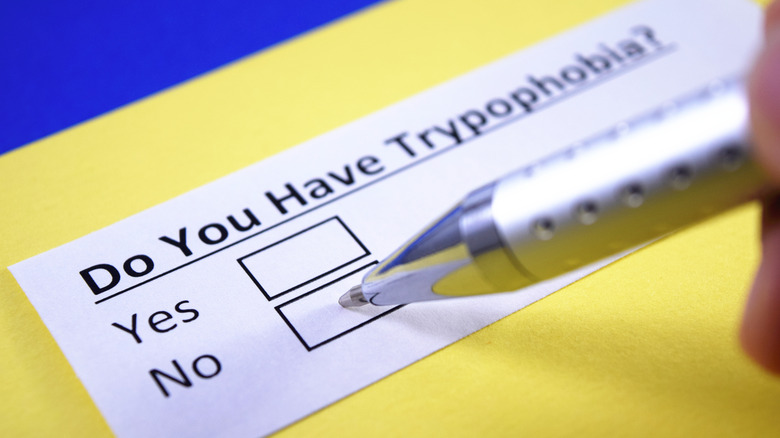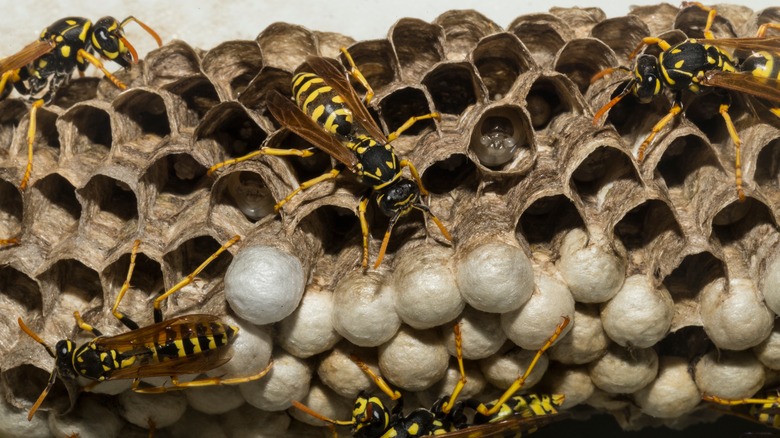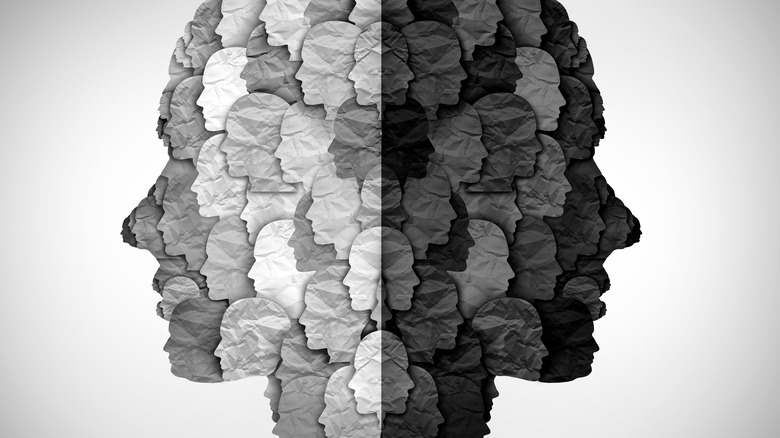The Science Behind Trypophobia Explained
People are afraid of all kinds of things. Afraid of potentially dangerous creatures like snakes or spiders. Afraid of the dark. Afraid of flying or heights or being in enclosed spaces. If you have an intense fear (phobia) connected to any of those things, nobody would be too surprised.
But there are also more rare phobias that seem out of a science fiction or horror movie. There's xanthophobia (fear of the color yellow), globophobia (fear of balloons), and eisoptrophobia (fear of mirrors), according to The Recovery Village). And then there's trypophobia: Up to one in six people might suffer from it (per Cleveland Clinic).
Simply put, trypophobia is an irrational fear response to patterns involving a lot of holes. According to Frontiers in Psychiatry (posted at the National Library of Medicine), trypophobia is an intense fear or disgust not only toward surfaces with lots of holes, but also protrusions or repetitive patterns. Healthline defines it specifically as a fear of "closely packed holes." The reaction can also be caused by a number of other patterns clustered together. The images don't even have to be seen in real life — sometimes seeing them online or in a magazine can have the same effect (via VeryWell Mind).
So is this a real condition?
As to the reality of the condition, the jury is still out right now. At present, trypophobia is not recognized as a mental disorder or genuine condition and is not listed in the American Psychiatric Association's Diagnostic and Statistical Manual of Mental Disorders (via VeryWell Mind). Studies regarding the topic have been very limited so far and unable to confirm if it could qualify as a unique, separate phobia. This is partially because of how this phobia was first identified — not by a psychiatrist or a scientist, but by a mention in an online forum back in 2005, as reported via Healthline.
To be clear, it's not that medical experts are saying you're imagining your trypophobia. After all, if you're afraid of holes, then nobody can tell you that you aren't. What experts are saying is that trypophobia might not be an actual phobia, but perhaps just a general discomfort with certain patterns. For example, for trypophobia to be considered a phobia, it would have to be a fear of objects with lots of small holes. But a study published in Psychological Reports (also at the National Library of Medicine) points out that people might not be afraid of the holes themselves but what the holes represent — more specifically, a fear of venomous animals that might live in spaces that look like that.
What triggers it?
Because trypophobia is poorly understood, there's no "official" list of what might trigger a reaction. It's very possible that some people might have a response to only some specific patterns, while others are more sensitive and might react to many different objects. According to VeryWell Mind, some things that can trigger trypophobia include fruit seeds, coral, honeycombs, insect eyes, and lotus seed pods. And yes, the possibilities include even harmless-looking things like bubble wrap, strawberries, or sponges. In extreme cases, animals with spotted coats, like leopards, might cause a reaction.
Healthline adds that some people have reactions to seeded breads, Swiss cheese, pomegranates, cantaloupes, and condensation, or bubbles. But how people react to these things differs from one person to the next. Some people might only react to patterns where the holes are irregularly placed or shaped, while others might find all holes unnerving. More severe cases would mean that even looking at a showerhead could trigger a reaction, while others would be perfectly fine with it. WebMD adds some unusual things that can trigger trypophobia in some people, such as the holes on a hockey mask, pebbles in concrete, and spots on the skin. For people with more extreme reactions, the LED bulbs in traffic lights can trigger a significant reaction.
How does it start?
Since experts don't know much about trypophobia, they can't exactly say just yet what causes it. There are some theories out there about what it could relate to, though these theories don't explain how it might start. It's possible trypophobia could be a genetic response to things that resemble disease or parasites — your brain reacts to things that look like an infectious disease that you need to avoid to survive (via Cognition and Emotion, posted at Taylor Francis Online). Other studies have shown it's possible your brain associates holes with dangerous situations or animals, as in the case of honeybee combs (per Psychological Science).
It's also possible that trypophobia might simply be connoted to disorders like anxiety and depression. In a case study published by Frontiers in Psychiatry, a 12-year-old girl was taken to a psychiatrist by her mother because the child was experiencing unusual reactions to certain objects with holes or dots. While the girl couldn't say when or how the fear had started, the mother could remember a situation in which the daughter had run out of a bathroom that was under repair, and the wall looked like a dotted pattern. However, the child had been under care of a doctor before for anxiety disorder and was experiencing excessive worries, uncertainty about her future, and anxious dreams. The conclusion? Her trypophobia was likely a manifestation of her anxiety, or at least connected to it somehow.
Signs and Symptoms
Symptoms of trypophobia vary from person to person, and not everybody experiences the same level of fear. In the case of the girl in the Frontiers in Psychiatry study, symptoms included increased heart and breathing rate, agitation, nausea, and sweating. For other people, it might lead to milder symptoms, like goosebumps and itching, or severe symptoms, like vomiting and panic attacks (per VeryWell Mind).
In a study where people were asked about their symptoms of trypophobia, 29.7% reported moderate anxiety and over 15% said they had severe anxiety. An additional 16% reported panic attacks. More than 50% of the people interviewed reported itchiness, goosebumps, and nausea as the main symptoms (per Brazilian Journal of Psychiatry). These symptoms indicate that, for many, trypophobia might actually be a repulsion reaction rather than a fear reaction. Nausea, chills, and discomfort are more commonly associated with disgust than fear. For those experiencing more serious reactions, including dizziness, panic attacks, or trembling, the effects are certainly different (via Healthline).
Trypophobia often runs in families. In many people, it occurs at the same time as other mental disorders. The study shows that 19% of people suffering from trypophobia had also been diagnosed with depression, and over 17% have been diagnosed with generalized anxiety disorder. WebMD points out that obsessive-compulsive disorder (OCD) and panic disorder can also be seen in people suffering from trypophobia.
Treatment
Treating trypophobia can be tricky, because it's not a recognized disorder. Still, if a medical expert feels somebody is suffering from it, they might recommend a number of different options. In the case of the young girl, treatment with an antidepressant (sertraline) plus cognitive behavioral therapy (CBT) resulted in a 25% improvement after five weeks (per Frontiers in Psychiatry).
According to Medical News Today, another common type of treatment for trypophobia is exposure therapy, also known as desensitization. Exposure therapy is exactly what it sounds like: a slow, well-managed, safe exposure to a phobia. This will help a patient learn how to deal with feelings and reactions when exposed to the fear. For this to work, it needs to be done at a pace the patient can handle. At first, just looking at a photo of the object might be all the person can do. The next step might include looking at a real-life product that would trigger the response, before the patient could tolerate a longer period of exposure, or even touch it (per Mayo Clinic).
Prescriptions, like sedatives, might also help with anxiety. There are also plenty of at-home techniques somebody with trypophobia could try, such as mindfulness and relaxation strategies.
